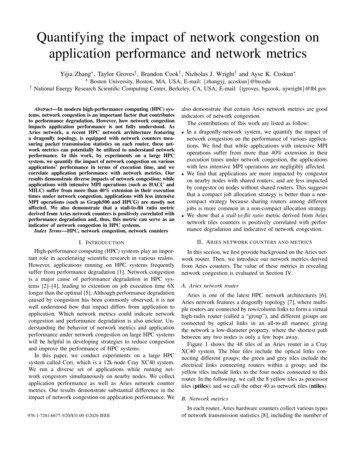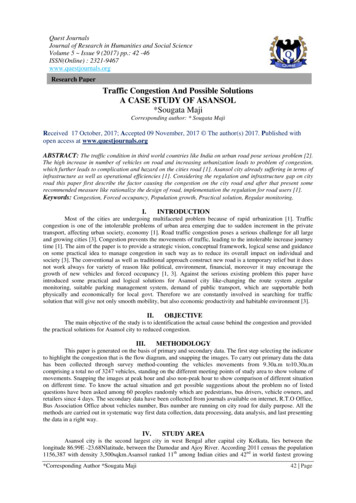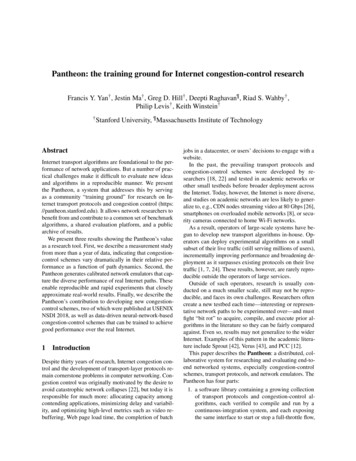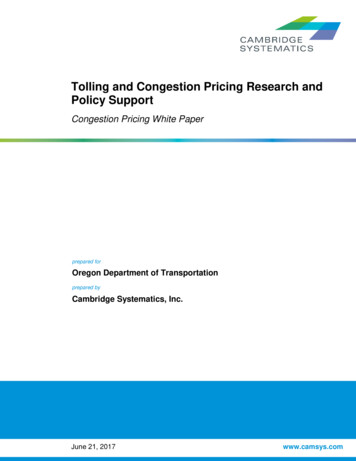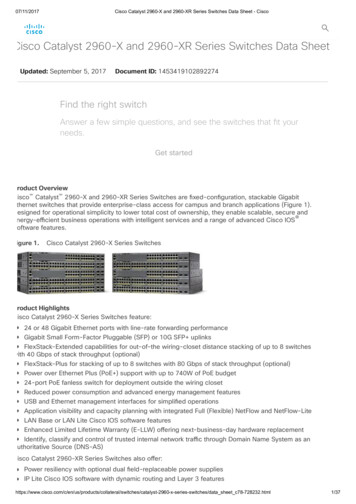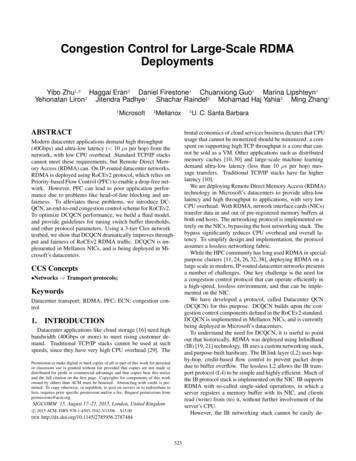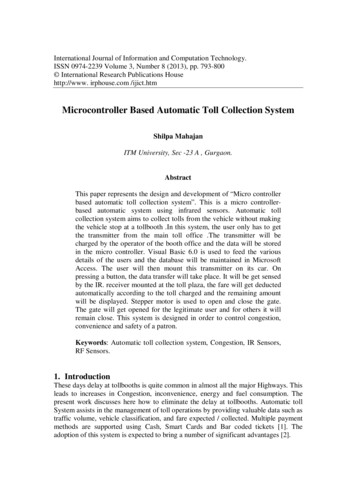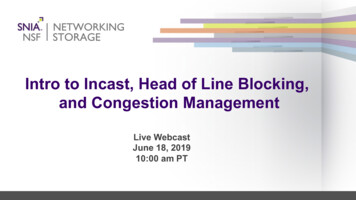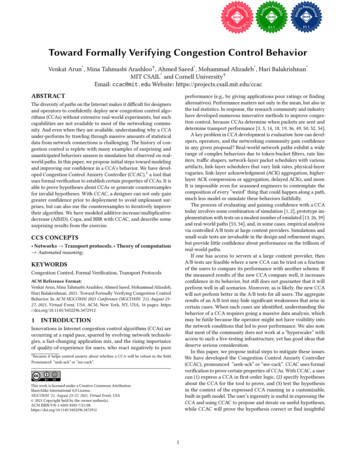
Transcription
Toward Formally Verifying Congestion Control BehaviorVenkat Arun* , Mina Tahmasbi Arashloo† , Ahmed Saeed* , Mohammad Alizadeh* , Hari Balakrishnan*MIT CSAIL* and Cornell University†Email: ccac@mit.edu Website: ance (e.g., by giving applications poor ratings or findingalternatives). Performance matters not only in the mean, but also inthe tail statistics. In response, the research community and industryhave developed numerous innovative methods to improve congestion control, because CCAs determine when packets are sent anddetermine transport performance [3, 5, 14, 18, 19, 36, 49, 50, 52, 54].A key problem in CCA development is evaluation: how can developers, operators, and the networking community gain confidencein any given proposal? Real-world network paths exhibit a widerange of complex behaviors due to token-bucket filters, rate limiters, traffic shapers, network-layer packet schedulers with variousartifacts, link-layer schedulers that vary link rates, physical-layervagaries, link-layer acknowledgment (ACK) aggregation, higherlayer ACK compression or aggregation, delayed ACKs, and more.It is impossible even for seasoned engineers to contemplate thecomposition of every “weird” thing that could happen along a path,much less model or simulate these behaviors faithfully.The process of evaluating and gaining confidence with a CCAtoday involves some combination of simulation [1, 2], prototype implementation with tests on a modest number of emulated [13, 26, 39]and real-world paths [53, 54], and, in some cases, empirical analysisvia controlled A/B tests at large content providers. Simulations andsmall-scale tests are invaluable in the design and refinement stages,but provide little confidence about performance on the trillions ofreal-world paths.If one has access to servers at a large content provider, thenA/B tests are feasible where a new CCA can be tried on a fractionof the users to compare its performance with another scheme. Ifthe measured results of the new CCA compare well, it increasesconfidence in its behavior, but still does not guarantee that it willperform well in all scenarios. Moreover, as is likely, the new CCAwill not perform better in the A/B tests for all users. The aggregateresults of an A/B test may hide significant weaknesses that arise incertain cases. When such cases are identified, understanding thebehavior of a CCA requires going a massive data analysis, whichmay be futile because the operator might not have visibility intothe network conditions that led to poor performance. We also notethat most of the community does not work at a “hyperscaler” withaccess to such a live-testing infrastructure, yet has good ideas thatdeserve serious consideration.In this paper, we propose initial steps to mitigate these issues.We have developed the Congestion Control Anxiety Controller(CCAC), pronounced “seek-ack” or “see-cack”. CCAC uses formalverification to prove certain properties of CCAs. With CCAC, a usercan (1) express a CCA in first-order logic, (2) specify hypothesesabout the CCA for the tool to prove, and (3) test the hypothesisin the context of the expressed CCA running in a customizable,built-in path model. The user’s ingenuity is useful in expressing theCCA and using CCAC to propose and iterate on useful hypotheses,while CCAC will prove the hypothesis correct or find insightfulThe diversity of paths on the Internet makes it difficult for designersand operators to confidently deploy new congestion control algorithms (CCAs) without extensive real-world experiments, but suchcapabilities are not available to most of the networking community. And even when they are available, understanding why a CCAunder-performs by trawling through massive amounts of statisticaldata from network connections is challenging. The history of congestion control is replete with many examples of surprising andunanticipated behaviors unseen in simulation but observed on realworld paths. In this paper, we propose initial steps toward modelingand improving our confidence in a CCA’s behavior. We have developed Congestion Control Anxiety Controller (CCAC),1 a tool thatuses formal verification to establish certain properties of CCAs. It isable to prove hypotheses about CCAs or generate counterexamplesfor invalid hypotheses. With CCAC, a designer can not only gaingreater confidence prior to deployment to avoid unpleasant surprises, but can also use the counterexamples to iteratively improvetheir algorithm. We have modeled additive-increase/multiplicativedecrease (AIMD), Copa, and BBR with CCAC, and describe somesurprising results from the exercise.CCS CONCEPTS Networks Transport protocols; Theory of computation Automated reasoning;KEYWORDSCongestion Control, Formal Verification, Transport ProtocolsACM Reference Format:Venkat Arun, Mina Tahmasbi Arashloo, Ahmed Saeed, Mohammad Alizadeh,Hari Balakrishnan. 2021. Toward Formally Verifying Congestion ControlBehavior. In ACM SIGCOMM 2021 Conference (SIGCOMM ’21), August 23–27, 2021, Virtual Event, USA. ACM, New York, NY, USA, 16 pages. https://doi.org/10.1145/3452296.34729121 INTRODUCTIONInnovations in Internet congestion control algorithms (CCAs) areoccurring at a rapid pace, spurred by evolving network technologies, a fast-changing application mix, and the rising importanceof quality-of-experience for users, who react negatively to poor1 Becauseit helps control anxiety about whether a CCA will be robust in the field.Pronounced “seek-ack” or “see-cack”.This work is licensed under a Creative Commons AttributionShareAlike International 4.0 License.SIGCOMM ’21, August 23–27, 2021, Virtual Event, USA 2021 Copyright held by the owner/author(s).ACM ISBN 52296.34729121
SIGCOMM ’21, August 23–27, 2021, Virtual Event, USAV. Arun et al.counterexamples that disprove the hypothesis. A proof providesconfidence that the CCA will perform well under all conditionsconsistent with the path model. On the other hand, counterexampleshelp in understanding corner cases mishandled by the CCA, andcan help the user improve its design. Our work aims to providean analytical tool that can capture unusual behaviors previouslyaccessible only through empirical methods.CCAC relies on a built-in path model that captures the complexsub-RTT behaviors observed on real network paths. The modeldoes not attempt to characterize specific behaviors, but is insteadconstructed to capture the composition of a wide range of possibilities, including token bucket filters and ACK aggregation. Thus,a proof that a CCA satisfies a hypotheses with this model givesus confidence that it will satisfy the hypothesis on a substantialportion of real-world paths.We have used CCAC to better understand classical AIMD, Copa,and BBR. Our findings include:can send a burst of packets when it detects a large number of losses.Ideally, this is the time to be conservative and avoid sending a burst!Intuitively, one might expect this cannot happen because AIMDwould decrease its cwnd by half. CCAC generated a counterexamplethat sidesteps this mitigation. In the counterexample, loss happensin two steps. When the second burst of losses are detected, the cwndhas already been halved once and will not be halved again sincethe losses belong to the same window of data [22]. Instead, the lossprompts a burst of packets from the sender, which triggers anotherloss. These bursts are bad because they can cause under-utilization.For example, AIMD can drop its cwnd twice in quick succession,leading to utilization as low as 50% even when the buffer is aslarge as 2 BDP. Although IETF RFCs have included mitigations forsimilar situations, CCAC sidesteps those as well. We discuss thiscounterexample in more detail in Section 7.Prior mathematical methods of congestion control fail to characterize these behaviors because they ignore complex sub-RTTdynamics. We find that sub-RTT dynamics strongly influence theperformance of a CCA, sometimes degrading utilization by an orderof magnitude (see §6, §7 and, §8). CCAC fills this gap in our understanding of such behaviors. It uncovers surprising CCA behaviorthat the user or designers of the CCA may not have anticipated. Inaddition, it can help prove bounds on the performance of CCAs,including on steady-state behavior.To provide the machinery to reason about sub-RTT jitter andpacket/ACK dynamics, we need a framework that can capture awide range of network behavior and a systematic way to expressCCAs and hypotheses about them. Such a framework should be:(1) expressive, capturing a wide range of networks, algorithms, andnetwork stacks;(2) interpretable, providing formal proofs to support its findings orcounterexamples understandable by a human expert; and(3) iterative, allowing the user to ask a wide range of queries aboutthe behavior of a CCA while iterating on the algorithm andtuning/customizing network behavior. Sub-RTT variability and bursts in packet or ACK delivery causeloss patterns and suboptimal performance in surprising waysfor even the well-studied AIMD scheme. For example, CCACfound that it is possible to cause AIMD to transmit packets in aburst right after it detects loss. This burst can cause another loss,leading to severe under-utilization. CCAC also proved boundson when such bad behavior can occur. For Copa, CCAC proved that when there is only one jittery network element on the path, utilization can drop to 50%, but nolower. With a sequence of jittery network elements, however,CCAC found that the worst-case throughput is near-zero! For BBR, CCAC found a network behavior that prevents BBR’sbandwidth probe from discovering available bandwidth evenwhen it is available. Analyzing the example by hand, we proposea fix that prevents CCAC from being able to force low utilization.Facebook has independently adopted this fix in their implementation of BBR in mvfst [27], their implementation of QUIC [28].In this paper, we focus on the worst-case behavior of a single endto-end congestion-controlled flow operating over complex networkpaths, without considering in-network feedback control. We donot consider inter-flow fairness propositions. We discuss theselimitations and future work in Section 9.2Achieving these objectives, particularly proofs, requires the ability to examine an astronomically large number of network scenarios.Fortunately, the formal verification community has been developingautomated tools for examining such large spaces for satisfiabilityqueries. These tools have been applied for verifying the correctnessof software and hardware. Automated theorem provers either provethat the software has the desired behavior or give a counterexampleof an input that breaks the software [16]. In this paper, we introducea performance-as-correctness framework that applies these ideas tocongestion control.MOTIVATIONTo appreciate what a formal verification tool like CCAC can doto improve our understanding of CCAs, consider classical AIMD.Standard textbook analysis assumes that loss occurs only when thecongestion window (cwnd) exceeds the bandwidth-delay product(BDP) plus the buffer size. In practice, links like Wi-Fi use “frameaggregation” to improve MAC-layer efficiency by sending packetsin bursts. These generate transport-layer ACK bursts. When ACKsarrive in a burst, however, we know that the sender will respondby sending new packets in a burst.2 These bursts can cause packetdrops, under-utilizing the link, defeating the Wi-Fi mechanism.CCAC not only models these issues, but it also identifies subtlebehaviors. For instance, CCAC uncovered a problem where AIMD3OVERVIEWCCAC allows the user to express a CCA in first-order logic, anda hypothesis about performance properties as logical formulae.Then, it uses an automated prover to do the bulk of the work. Thetheorem prover either proves that the performance property alwaysholds under CCAC’s path model, or generates counterexamplesinvalidating the hypothesis.The path model. The model abstracts complex network pathsby a single path-server with a FIFO queue followed by a fixed delay,leveraging ideas from Network Calculus [11, 33]. The path-server2 Burst transmissions can happen even with a paced sender, because implementations(including the Linux kernel [38]) often pace packets faster than the estimated rate toavoid under-utilization.2
Toward Formally Verifying Congestion Control BehaviorSIGCOMM ’21, August 23–27, 2021, Virtual Event, USACCA specification:Ó(( 𝑙𝑜𝑠𝑠 𝑑𝑒𝑡𝑒𝑐𝑡𝑒𝑑𝑡 𝑐𝑎𝑛 𝑑𝑒𝑐𝑟𝑡 ) cwnd𝑡 12 cwnd𝑡 1 )Ó𝑡𝑡 (( 𝑙𝑜𝑠𝑠 𝑑𝑒𝑡𝑒𝑐𝑡𝑒𝑑𝑡 𝑐𝑎𝑛 𝑖𝑛𝑐𝑟 𝑡 ) cwnd 𝑡 cwnd 𝑡 1 𝛼)Query:Ô𝑡 (𝑙𝑜𝑠𝑠 ℎ𝑎𝑝𝑝𝑒𝑛𝑒𝑑𝑡 cwnd 𝑡 1BDP)buffer size 2 BDP, max. jitter 1 RTTso that the bad behavior no longer exists, or (c) restrict the pathserver’s model to exclude the cases that trigger the bad behavior.In the last case, the user will know what additional constraints onthe network are necessary for the CCA to work.The user repeats this process until they are confident that theyunderstand the bounds on the performance of their CCA. However,CCAC can only make statements over finite time horizons whennetwork parameters such as the link rate and propagation delayare constant. This does not prove the CCA always exhibits goodbehavior over arbitrarily long time horizons with varying networkparameters (e.g., varying link capacity). Nevertheless, the user canprove these general long-term theorems by mathematical inductionover lemmas that CCAC can prove (see §7.2 for an example).Example. Figure 1 shows the CCAC query used to discoverthe behavior of AIMD discussed in the previous section. CCACevaluates the behavior of algorithms over a finite number of timesteps. The behavior of the algorithm is defined at every time step;if loss (congestion) is detected and it has been an RTT since the lastreduction in cwnd, then halve cwnd. If no loss is detected for anRTT, then increase cwnd by 𝛼. The query asks if loss can happenwhen cwnd is less than or equal to 1 BDP. CCAC answered “yes”to this query and produced traces that contained the behaviors wediscussed for AIMD in §2, which we elaborate on in §7.Assumptions. Because CCAC focuses on worst-case behavior,a central goal of its design is to exclude excessively antagonistic behavior that no CCA can handle. Thus, the path model only includesa carefully chosen subset of paths (see §4.2). Our model of TCP timeouts is different from the standard for the same reason (see §4.3). Werepresent network state using cumulative functions that precludethe modeling of packet reordering. CCAC’s mechanism to detectpacket losses emulates endpoints that use an unbounded numberselective acknowledgment (SACK) blocks. This corresponds to theQUIC protocol [28], while TCP is limited to a maximum of fourSACK blocks [34].Figure 1: Query used to discover instances where AIMD cancause loss prematurely. 𝑐𝑎𝑛 𝑖𝑛𝑐𝑟 and 𝑐𝑎𝑛 𝑑𝑒𝑐𝑟 prevent AIMDfrom increasing/decreasing more than once per RTT.introduces a variable delay per packet. It can choose when to transmit or drop packets in its queue subject to certain constraints. Theconstraints seek to emulate a link with a fixed average capacityand a limited buffer, but allow for short-term deviation from thisaverage including an arbitrary per-packet delay jitter up to 𝐷 seconds (§4.2). The user can use this model to reason about variablecapacity links as well (§4.4).The power of this model is that, despite its simplicity, it captures a wide of range of underlying network-specific behaviors.Importantly, we do not specify any probability distribution overthe path’s behavior. Thus, the path-server is non-deterministic,but not random, restricting CCAC to worst-case analyses. Thisdecision was a conscious one, made for three reasons. First, theprobability distribution of link delays on the Internet is unknown,ever-changing, and depends on one’s vantage point. Second, manyin-network processes such as ACK aggregation and token-bucketfilters are deterministic, not random. Third, we are often interestedin the performance on the long tail of low-quality links (paths),whose behaviors would be buried by aggregate metrics. To ourknowledge, this paper presents the first analysis of worst-case CCAbehavior in such an expressive model.Input to CCAC. A CCAC user expresses their CCA and properties of interest as first-order-logic formulae. In principle, suchformulae can represent any circuit, but CCAC’s ability to reasonabout it depends on how the user expresses the CCA. Thus, theuser’s ingenuity is essential in expressing the CCA in a way thatenables automated reasoning. The user expresses a CCA as a function that maps past ACKs to a cwnd and/or rate. Further, theyexpress a property of the CCA as arbitrary constraints on the cwnd,utilization, delay, or packet loss, connected by logical operators.Examples of hypotheses (queries) include: “Does cwnd ever fallbelow 90% of BDP in 8 RTTs?” and “Is there any case where thequeue length starts below 1.5 BDP, but increases beyond 1.5 BDPwithin 20 RTTs?”In §5, we show how we encode the description of the pathserver, the CCA, and hypotheses about the CCA as a SatisfiabilityModulo Theories (SMT) problem, allowing CCAC to use Z3 [16] asits automated theorem prover.CCAC’s Operation. Typically, the user will formulate queriesto capture bad CCA behavior. CCAC searches through all possiblebehaviors of the path-server, subject to its constraints, to find anetwork trace where the CCA fails to achieve the property. If atrace exists, CCAC outputs it. Otherwise, CCAC outputs “unsat” informing the user that no such bad behavior exists, which proves theuser’s hypothesis about the CCA. When the user finds bad behaviorusing CCAC they can (a) live with it, (b) improve the algorithm4THE PATH MODELTo create a model that captures a broad range of network behaviors,we ensure it satisfies two properties. First, it can emulate knownbehaviors such as ACK aggregation, token-bucket filters, and arbitrary per-packet delay up to 𝐷 seconds (see §4.2). Arbitrary delayscan be used to emulate scheduling errors, MAC scheduling artifacts,and delay-measurement errors. Second, it composes; i.e., for anytwo path-servers, there exists a path-server, perhaps with differentparameters, that can do anything that the two path-servers can dowhen placed serially. Hence, the path-server can also emulate anysequential composition of the above behaviors.Our initial attempts at creating a general path model producedmodels that were “too expressive” and allowed behaviors that noCCA can handle. We discuss some of these behaviors and howour final model avoids them in §4.2. We believe we have strucka good balance between expressiveness and restricting unreasonable behavior because CCAC produces network behaviors that areplausible on real networks.3
SIGCOMM ’21, August 23–27, 2021, Virtual Event, USAV. Arun et al.(A)C tokens/secACKsPacket QueuePathserverL(t)A(t)rve,al cuArriv Queuing delayQ(t)Figure 2: CCAC’s path model.T(t) C)peSlo stageaw((t),SeurveCicrvSeDBounds on S(t)sLos ned!pehap C )epeSlo r size, 𝛽Time𝐶 – link rate𝑅𝑚 – propagation delay𝛽 – buffer size𝐷 – max per-packet jitter𝛼 – MTU sizedupacks (threshold) – 3𝛼𝑇 – number of time stepscwnd (𝑡) – congestion window𝑄 (𝑡) – packet queue length 𝑇 (𝑡) – token queue length𝐴(𝑡) – cumulative arrivals𝑆 (𝑡) – cumulative service𝑊 (𝑡) – cumulative waste𝐿(𝑡) – cumulative losses𝐿𝑑 (𝑡) – cum. losses detected 𝜏𝑜 (𝑡) – timeout happenedTable 1: Glossary of symbols.4.1(B)(C)Constant Delay, RmCumulative bytesSenderArriving pktsToken QueueCumulative bytesBottleneck queuecwndRmA(t) S(t - Rm) cwndTimeFigure 3: Graphical representation of the constraints.value in units of BDP. The user can also set 𝛽 to or let CCACsearch over all its possible values to find one that satisfies the query.Formal definition. Let 𝑄 (𝑡) and 𝑇 (𝑡) denote the number ofbytes in the packet and token queues, respectively. 𝐴(𝑡) denotesthe cumulative number of bytes that have arrived at the servertill time 𝑡. Similarly 𝑆 (𝑡), 𝐿(𝑡), and 𝑊 (𝑡) are the cumulative number of bytes serviced from the path-server, bytes lost, and tokenswasted, respectively (see Table 1). A number of constraints boundthe behavior of the network, and therefore, these functions: Tokens arrive at rate 𝐶 bytes/s but at time 𝑡, 𝑆 (𝑡) of themhave been used and 𝑊 (𝑡) of them have been wasted. Hence,𝑇 (𝑡) 𝐶𝑡 𝑊 (𝑡) 𝑆 (𝑡). The queue length is the number of bytes that have arrivedbut have not been serviced or lost. Hence, 𝑄 (𝑡) 𝐴(𝑡) 𝐿(𝑡) 𝑆 (𝑡). Wastage can only happen when there are more tokens thanpackets. That is, 𝑇 (𝑡) 𝑄 (𝑡) 𝑊 ′ (𝑡) 0, where 𝑊 ′ (𝑡) isthe time derivative indicating how much waste occurred. Loss is disallowed unless the bottleneck queue, 𝑄 (𝑡) 𝑇 (𝑡),exceeds 𝛽 bytes. Hence, 𝑄 (𝑡) 𝑇 (𝑡) 𝛽 𝐿 ′ (𝑡) 0. Wealso have 𝑄 (𝑡) 𝑇 (𝑡) 𝛽. Naturally, 𝑄 (𝑡) 0 and 𝑇 (𝑡) 0 and the cumulative functions 𝐴(𝑡), 𝑆 (𝑡), 𝐿(𝑡), and 𝑊 (𝑡) are all non-decreasing. Sincewastage can happen only when tokens enter the queue,𝐶𝑡 𝑊 (𝑡) should also be non-decreasing. Finally, the server would not have admitted tokens if theywere going to stay in the queue for more than 𝐷 seconds.Hence, all tokens that arrived 𝐷 seconds ago and were notwasted must have been used by now. That is, 𝑆 (𝑡) 𝐶 ·(𝑡 𝐷) 𝑊 (𝑡 𝐷). Together with 𝑇 (𝑡) 0, we have that𝐶 · (𝑡 𝐷) 𝑊 (𝑡 𝐷) 𝑆 (𝑡) 𝐶𝑡 𝑊 (𝑡). These are thebounds on the service curve, 𝑆 (𝑡).Visualization. To make it easier to present examples of network behavior in our model, we introduce a standard graphicalrepresentation shown in Figure 3. The representation is akin toTCP’s time sequence graph, where the 𝑥-axis represents time andthe 𝑦-axis represents the cumulative number of bytes arriving atthe path-server (i.e., arrival curve) or served from it (i.e., servicecurve). Figure 3(A) illustrates a simple example with the arrivalcurve in blue, the service curve in red, and the bounds on the servicecurve in black. Note that 𝐴(𝑡) 𝐿(𝑡) is the cumulative number ofbytes admitted to the queue. The horizontal gap between the blackModel SpecificationIntuition. The path-server can be described as a generalized tokenbucket filter (TBF) as shown in Figure 2. First, consider a regularTBF. It has two queues, one for packets and another for tokens.Tokens arrive continuously at a fixed rate of 𝐶 bytes/second and apacket of size 𝑥 bytes can be dequeued only if the token queue hasat least 𝑥 bytes worth of tokens. If no packets arrive for a while,tokens accumulate to a maximum of 𝐾 bytes. Any tokens that comeafter the token queue is full are wasted. Then, if packets arrivein a burst, the TBF can transmit a burst of up to 𝐾 bytes at once,temporarily exceeding the link rate 𝐶.Our path-server generalizes this scheme. When a token arrives atthe token queue, the path-server can non-deterministically chooseto either admit it or waste it. Wasting is allowed only when thereare more tokens than the total number of bytes in the packet queue.Like a TBF, when a packet is dequeued, a number of tokens equalto the packet’s size are dequeued. However, unlike a TBF, the pathserver can choose to delay sending packets even when tokens areavailable, subject to the constraint that once a token is admitted,the token cannot be in the queue for more than 𝐷 seconds. Thismechanism gives the path-server 𝐷 seconds of slack to emulatevarious network effects. In addition, the 𝐷-second bound constrainsthe maximum number of tokens to 𝐶 · 𝐷.Recall that the path-server models an entire path, not just the bottleneck. Therefore, the packets in the path-server’s queue representpackets enqueued throughout the path, not just at the bottleneck.The bottleneck queue is represented by the difference betweenthe total number of bytes in the packet queue and the number ofavailable tokens. Hence, the server can waste tokens only if thisdifference is 0, indicating that the bottleneck is empty.3 To emulate a bottleneck buffer of 𝛽 bytes, the server drops packets whenthe bottleneck queue exceeds 𝛽 bytes. The user can set 𝛽 to a finite3 Notethat if packets are arriving too slowly, the server is forced to waste tokens toavoid keeping a token for more than 𝐷 seconds.4
Toward Formally Verifying Congestion Control BehaviorSIGCOMM ’21, August 23–27, 2021, Virtual Event, USA4.2Cumulative bytescurves is 𝐷. The horizontal gap between the arrival and servicecurve represents the time spent by a packet in the path-server’squeue (which does not include 𝑅𝑚 , the propagation delay). Thevertical gap represents 𝑄 (𝑡). The vertical gap between the servicecurve and upper black curve equals 𝑇 (𝑡) and represents the largestburst possible at this time.Wastage is disallowed when 𝑇 (𝑡) 𝑄 (𝑡). Substituting 𝑇 , 𝑄, andrearranging, we get 𝐶𝑡 𝑊 (𝑡) 𝐴(𝑡) 𝐿(𝑡). Hence, wastage ispossible only when the arrival curve is less than the upper blackcurve (see Figure 3(B)). When wastage happens, the slope of theblack curve is smaller than 𝐶, indicated by dotted lines in the figure.Figure 3(C) shows we can define a loss threshold curve, which is theupper black curve plus 𝛽. The arrival curve must remain below thisline, and loss is allowed only when the arrival curve touches thisline. The sender detects losses when it receives dupacks numberof acknowledgments of packets after the loss event. Figure 3(D)shows how a CCA that simply maintains a constant cwnd controls𝐴(𝑡) in response to 𝑆 (𝑡). Here, 𝐴(𝑡) 𝑆 (𝑡 𝑅𝑚 ) cwnd becausethe ACKs leaving the server will reach the sender 𝑅𝑚 seconds later,which maintains cwnd packets in flight.Token bucket filterAck aggregationBurst size CDTimeTimeFigure 4: Examples of how the path-server emulates a tokenbucket filter and ACK aggregation.buffer size, respectively. When buffers are finite, our result is weaker:if 𝐶 1 𝐶 2 and 𝛽 2 𝐶 1 𝐷 1 , then their composition can be emulatedby a path-server with parameters (min(𝐶 1, 𝐶 2 ), 𝐷 1 𝐷 2, 𝛽 1 ) (seeTheorem 5 Appendix D). We do not yet have results for when𝐶 1 𝐶 2 and buffers are finite.Design decisions. The weakening of results with the constraint𝛽 2 𝐶 1 𝐷 1 is by design. If the path-server is able to emulate a burstybox followed by one with a small buffer, it can emulate a networkthat drops packets no matter what the CCA does. This is because,even if the CCA sent evenly spaced packets, the bursty box cangenerate bursts of up to 𝐶𝐷 bytes larger than the buffer size ofthe small-buffered box, leading to packet drops that a CCA cannotavoid. While such paths are possible on the Internet, it is not usefulto include them in the model because no CCA can help here. Thus,Theorem 5 considers only the case when the buffer size of 𝜏2 isbig enough to absorb bursts created by 𝜏1 (𝛽 2 𝐶 1 𝐷 1 ). Indeed,we prove that when 𝐶 1 𝐶 2 and 𝛽 2 𝐶 1 𝐷 1 , the second box cannever lose packets (see Theorem 4 in Appendix D). Operationally,we achieved this by defining the condition for loss on 𝑄 (𝑡) 𝑇 (𝑡)and not on 𝑄 (𝑡), even though the latter might seem more natural(and is what we used in earlier iterations of our model).Another design decision was to limit the time a token can spendin the queue to 𝐷 seconds. It may seem more natural to limit thenumber of tokens in the queue to 𝐾 𝐶𝐷 𝐵𝐷𝑃 bytes instead(again, this is what we used in earlier iterations of the model). Here,there is nothing forcing the path-server to use tokens. If the sendersends fewer than 𝐾 bytes (say, because its initial cwnd 𝐾), theserver can hold on to the packets indefinitely, causing the senderto timeout. Requiring the initial window to be equal to the BDP isunreasonable, since determining the BDP is precisely the CCA’s job!Exclude this behavior by using 𝐷 instead of 𝐾 is a clean resolution.The Set of Paths CCAC CapturesThe behavior of a real network path can be decomposed into a seriesof “boxes”. Individual boxes represent various phenomena such asbottleneck links and ACK aggregation. In some cases, it helps todecompose one physical device as multiple boxes. For instance,the sender’s network stack can be broken into a component thatpacketizes and another that paces packets with timing errors.Individual “boxes”. Now we discuss which real network boxesthe path-server can emulate. Since it is a generalized TBF, it cannaturally implement a regular TBF as shown in Figure 4. If the TBFhas a link rate of 𝐶 and a burst size of 𝐾, then we can emulate itwith a path-server with the same link rate and 𝐷 𝐾/𝐶. When thesender stops sending, tokens accumulate, allowing the path-serverto burst when the sender bursts (i.e., the arrival curve has a largesingle-step increase). The path-server can burst a maximum of 𝐶 · 𝐷bytes, buffering the rest. Then, the TBF sends data from its bufferat a rate of 𝐶.The path-server can also emulate a constant-bit rate (CBR) linkwith rate 𝐶 followed by an arbitrary delay box (see Theorem 3in Appendix D). The delay box can non-deterministically delayevery byte by an arbitrary amount as long as it does not reorderbytes and no byte stays in the delay box for longer than 𝐷 seconds.Thus, the CBR delay box can emulate a wide range of phenomenasuch as packetization, ACK aggregation, scheduling errors, MAClayer jitter, and arbitrary delays ( 𝐷). The second example inFigure 4 shows the behavior of an ACK aggregator. Regardless ofthe sending rate of the arrival curve, the service curve aggregatespackets (which is the effect of ACK aggregation) and sends them inbursts. Note that the CBR delay box cannot emulate token bucketfilters, while the path-server can.Composition. If network boxes 𝜏1 and 𝜏2 can be emulated bypath-servers with infinite buffers (𝛽 ) and parameters (𝐶 1, 𝐷 1 )and (𝐶 2, 𝐷 2 ), then the composition of 𝜏1 and 𝜏2 can be emulated by apath-server with parameters (min(𝐶 1, 𝐶 2 ), 𝐷 1 𝐷 2 ) (see Theorem 7in Appendix D), where 𝐶, 𝐷, 𝛽 are the link rate, jitter parameter, and4.3Expressing CCAsA CCA controls the sende
(CCAC), pronounced "seek-ack" or "see-cack". CCAC uses formal verification to prove certain properties of CCAs. With CCAC, a user can (1) express a CCA in first-order logic, (2) specify hypotheses about the CCA for the tool to prove, and (3) test the hypothesis in the context of the expressed CCA running in a customizable, built-in path .
